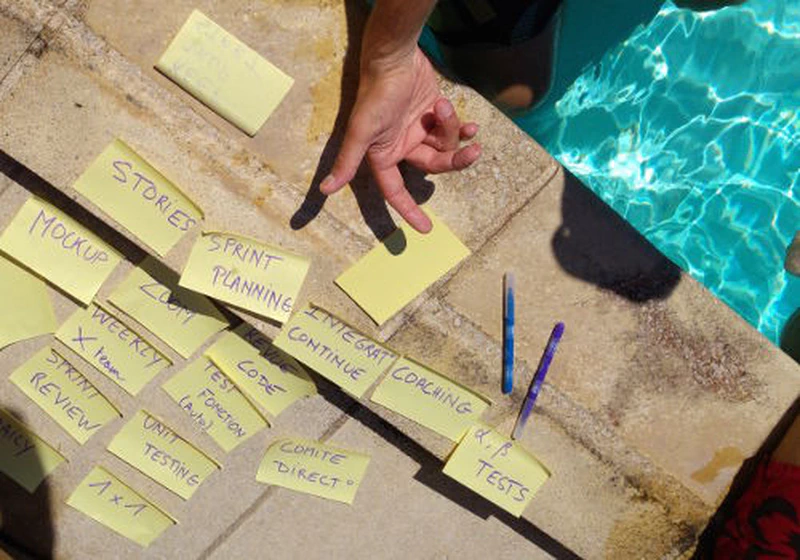Since we’re on the subject of games (coin game) or educational workshops, here’s an update on the practice sawmill. Some proposals are not new at all, but I had never published them. So I think the Practice Sawmill page is somewhat obsolete.
Let the practices emerge
It was Stéphane who quickly proposed this evolution, and over time it has proven its relevance. The important thing is not to give a list of practices upfront but to ask participants to list their practices (say 12/16 practices). Simply put. But it’s remarkably effective, while opening the approach to all domains.
How does it work? At raid agile for example, we ask participants to write on post-its twelve to sixteen practices they use regularly, or simply that they know, that they’ve heard about. Then the usual game takes over. You ask them to reduce this list to six, and to explain why these six are the most important. That’s the whole point of the practice sawmill, beyond the practices, it’s the substance of things that emerges: principles, values, etc.
Finally you ask them to reduce this list to two items and to explain again. Having groups interact is often also very stimulating: each explains and presents to the other groups.
At raid agile we also used the practice sawmill to instantiate the elements of a following workshop on Agile Fluency which we’ll talk about soon with Claudio.
A universal practice sawmill
In fact, the practice sawmill workshop becomes universal (in the sense that it’s not limited to agile practices). I was recently able to use it for example with a team of journalists. What are your daily practices? Okay. Is it possible to tell me which are the six most important and why? And if only two had to remain?
Another scenario, I’m accompanying a job interview (at beNext, where I’m having a great time). What are the daily practices of a human resources manager (yes we all know that the semantics aren’t ideal in this title)? If we had to focus on the five most important ones, which would they be and why? And if we had to keep only one?
With this way of doing things, everything becomes grounds for interesting conversation that beyond practices will question the foundations of a thought process, an approach, a profession.
Principle of continuous improvement

Now, depending on the context, following a practice sawmill, I return to the selection of the five or six most important practices and I ask, like a perfection game from Jim McCarthy’s Core Protocols, that the participants give me a feeling between zero and ten of the quality of their application regarding these practices. So imagine a group of journalists who tell you that one of their key practices is reporting local information (highly localized). You then ask them where they stand in the application of this practice. They will respond for example 6/10. The next question is naturally to ask them how we could go from six to seven, or from six to eight. It’s a common exercise, non-violent: doing better, and pragmatic, the target remains achievable, we increase by one or two points. And we thus seek to improve on the practices that have the most importance in our eyes.
Above, an image of a practice sawmill around the pool at raid agile.
But not the reaction circle
On the other hand, I haven’t really kept the reaction circle. Based on principles of sociocracy (or the “decider” from Jim McCarthy’s Core Protocols), from consent, I don’t see it working enough in my everyday life. Either the group is at most four to five people and it works, without a particular framework, without needing to set up a reaction circle. Or the group is beyond six and consent becomes artificial or really difficult to achieve (in the sense of too long and/or too frustrating).
In real life I prefer the now known “Advice Process” (read “Reinventing Organizations” by Frédéric Laloux, you can skip the entire first part…). The principle is simple: you want to do something, you must ask advice from people who are responsible for the domain (or domains) of your initiative. I want to use a particular technology, I’ll ask advice from the architecture or technical lead, or the group that manages architectural and technical aspects. I listen to their advice, their recommendations. If their advice goes against my proposal I can still implement it, acknowledging the responsibility that this makes me bear.
For people who know delegation boards, instead of doing “agree” (consensus), we switch to “consult” (consult), one notch further toward empowering people and teams than consent.